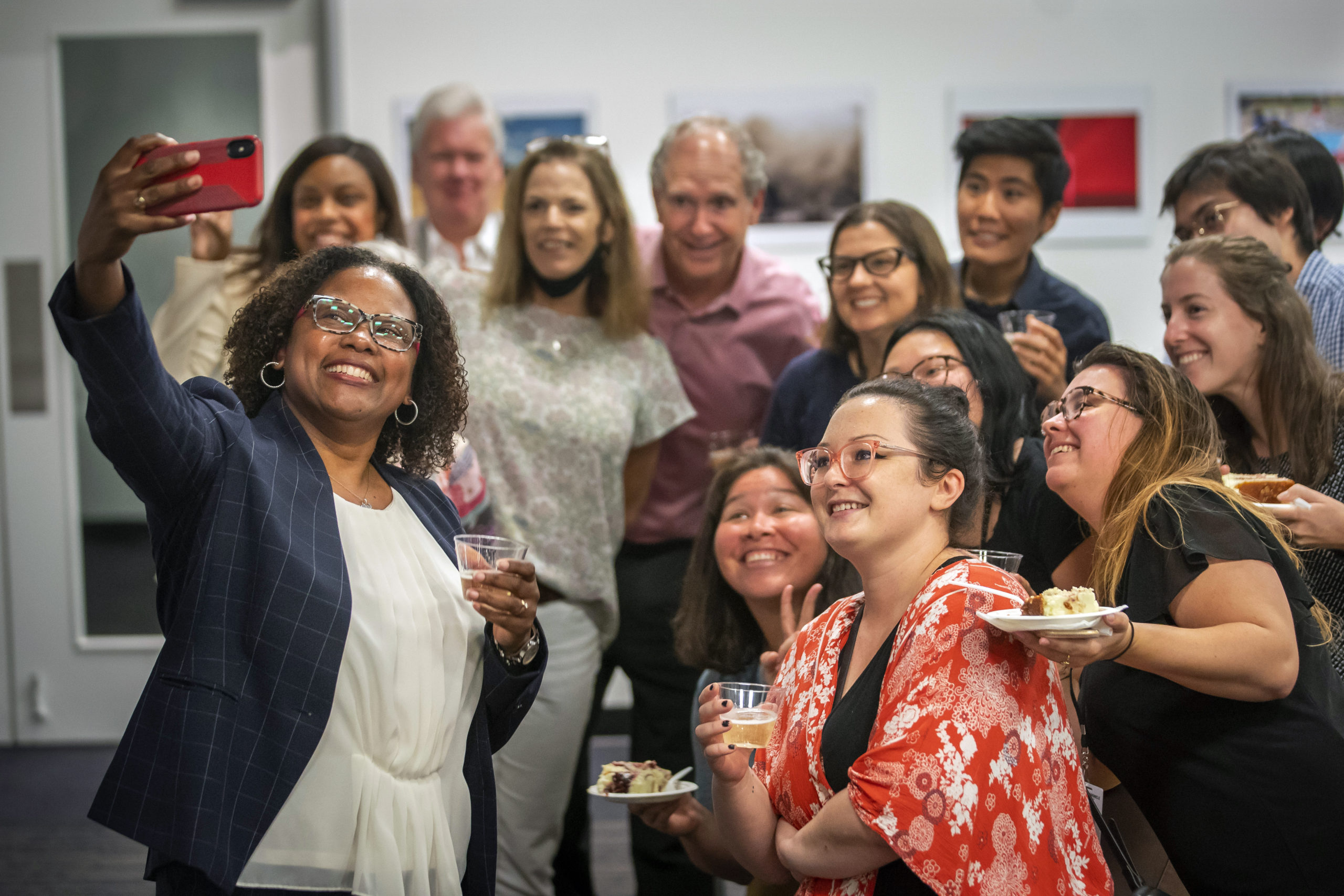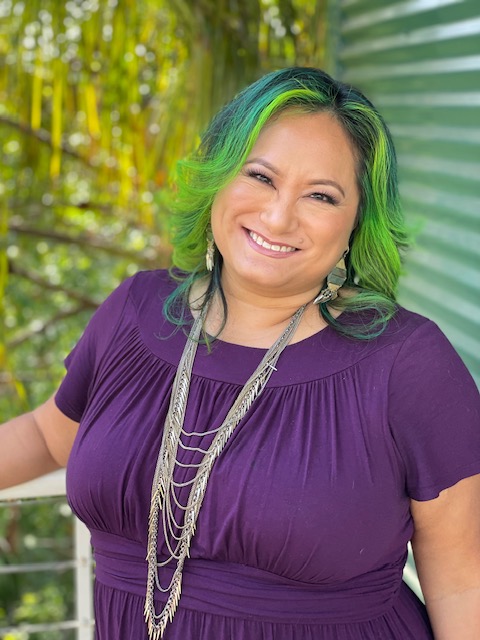
Maria Reeve celebrates as she is named the executive editor of the Houston Chronicle in July 2021. Reeve became the first person of color named as editor of the 120-year-old Houston daily
It’s a story we’ve heard over and over again: A newsroom makes a commitment to diversity and takes steps to bring in candidates from different backgrounds when it has open positions. But even when it successfully hires people from underrepresented communities, those employees may not thrive or may decide to leave if the news organization hasn’t done enough to create a truly inclusive culture.
What does a truly inclusive culture look like? Most newsrooms think of diversity and inclusion work primarily as an internal affair — being respectful to everyone in the organization and treating everyone within that sphere equally. But inclusion work can’t succeed in a bubble.
We’ve heard frequently from journalists in underrepresented groups that a lack of consideration for diverse audiences — and a feeling that the stories that matter to diverse communities aren’t prioritized or supported — has led them to leave a publication.
We believe that serving diverse audiences externally is as essential as creating an inclusive culture internally. The two are inextricably linked. The key here lies in audience engagement, and connecting it to your diversity, equity, and inclusion work.
Loosely defined, the culture of any newsroom is “how we do things around here.” And one of the biggest cultural markers of any newsroom is forged in editorial meetings where staff decisions of what’s considered “newsworthy” and a “good story” are made.
If decisions about what coverage gets prioritized, resourced, and promoted are ingrained in the perspectives of a historically homogeneous staff, it makes it all the more challenging for the perspectives and pitches of reporters and editors from more diverse groups to be accepted.
Furthermore, if a newsroom’s audience is less diverse than the population the newsroom aims to serve, then stories for the existing audiences will tend to perform better in terms of absolute metrics. This reinforces the status quo when newsrooms make decisions based primarily on those metrics — rewarding and repeating the same type of coverage that has “done well” in the past, creating yet another barrier to greenlighting stories of importance to smaller segments of its audience.
Engaging the audiences you want to serve, not only your largest current audiences, is a key way around this. While relying purely on editors’ gut instincts or “the way things have always been done” amplifies unconscious bias, collecting reader and viewer feedback that can shape editorial decisions — beyond topline metrics such as page views and unique visitors — does the opposite. It gives the whole newsroom the necessary opportunity to state the unspoken assumptions, get conscious about embedded biases, and unpack what gets covered and why.
Why it is necessary to look beyond those topline metrics? Those numbers show the behavior of your largest audiences, so if you’re trying to grow audiences that make up a minority of your overall audience today, you’ll miss them. Engaging with those smaller audiences qualitatively, not only quantitatively, is one way to understand how you can better include them. In 2017 and 2018, for example, HuffPost conducted a bus tour to less-covered locations across America, interviewing nearly 1,700 people about what mattered to them, then changed its editorial strategy accordingly. It also conducted regular reader surveys, polls, and focus groups to get more information.
When employees from underrepresented groups don’t truly have a seat at the table and the power to influence decision-making, efforts to diversify newsrooms can easily fall into the traps of tokenism, marginalization, or exploitation. Including more perspectives in the editorial decision-making process — and basing editors’ judgments on audience needs defined by research and data, not only their own experiences — can help newsrooms avoid those traps. And importantly: bringing engagement insights to editorial meetings also enables staff the treasured time to be creative, theorize, experiment, and learn together — which supports the entire organization in becoming more inclusive.
In short, news organizations won’t be able to make real progress on inclusion and equity unless and until they operationalize engagement with their communities and make it part of the core workflow.
So how can you incorporate the kind of inclusive engagement into your newsroom that supports a more inclusive workplace? There is no perfect formula for each newsroom, but there are durable principles and techniques that you can draw from to create your own strategy. And there are journalism support organizations that teach these practices.
Ask yourself the following questions:
What opportunities do individuals outside of your newsroom have to shape your stories and coverage decisions?
There are a variety of approaches to draw on here, from more traditional options — such as creating community advisory boards, publishing op-eds and letters to the editor, conducting surveys, and hosting events and office hours in the community — to bolder ones, including creating an open newsroom, opening editorial meetings to the public, running an information concierge desk for readers, and inviting community members to contribute insights or questions they’d like you to consider covering (public-powered journalism). The key is that whatever you do to include the public can’t be performative; it has to be meaningful.
Who actually hears those insights and questions from your audiences and communities?
In order to be meaningful, the outside engagement must be heard and acted upon. It’s critically important that the listening, feedback, and ideas that your audience-facing staff is collecting gets surfaced consistently in editorial meetings. If not, all of that feedback stays siloed and prevents the shaping of decisions about what content is prioritized and why. Consider making it a 15-minute part of your daily agenda to discuss what the newsroom is hearing from the public, or a particular audience segment, or community. You can also collect those insights from staff and send out a weekly email that summarizes the listening you’re doing and what decisions you’ve made based on that listening.
Does your newsroom have a stated commitment to listening and engagement?
In other words, how can you not be an extractive “askhole” in the engagement you do? How do you ensure that you’re not just counting how many people completed a survey or took some action that you can count as “engagement,” but that their insights actually shaped decisions that were made? Whenever you’re creating an opportunity for engagement and listening, it’s imperative that you tell people what to expect: What you will do with their insights or participation, and how it will matter? This could be as simple as explaining your process clearly, like Crosscut does for their public-powered work. If you’re constrained for space and doing a call to action on social media, create a page to link to that gives sufficient context as to why you’re asking and what will happen next. Just make sure you are willing to share the same information you are asking for.
Does your newsroom share back with the people who have engaged to thank them and let them know that they mattered?
Think of engagement as a ring, a feedback loop, that can’t be achieved until the full cycle is completed. People are going to wonder whether they should bother to engage if they don’t see their efforts making a difference.
One of the most important ways you can show that you’re listening to people outside of your core audience is by including them in the stories you create. On the deeper end of the inclusion spectrum, that can mean inviting members of the public to co-create, ride along, and be part of your reporting. Lighter methods involve including them as a source, publishing (with permission) a photo or video of their participation, and explaining how their involvement made a difference. The more a newsroom can show it’s serving a diverse audience, the more that staff who aren’t part of the historically included groups can feel assured they belong.
Does your newsroom track the diversity of your sources?
There are great efforts from a variety of organizations to help you understand whose voices you’re lifting up when doing reporting that doesn’t include more expansive audience engagement. Chalkbeat, America Amplified, and the Institute for Nonprofit News all have all shared their lessons learned on this front, while the American Press Institute has built an automated tool to audit a newsrooms sourcing. What all of these efforts help elucidate is that you can’t create a coordinated effort to “do better” without establishing a benchmark for how you’re doing. In many cases, newsrooms may not realize they have sourcing gaps until they begin collecting this data. Unveiling data about the diversity of your sourcing helps identify any underrepresentation, giving reporters a reason to think twice before reaching for the same old contacts, and is key to creating a strategy to widen your reach.
Taking the time to answer and discuss these questions should illuminate where there’s work to be done and help ensure your inclusion efforts — for your staff and your audiences — help to create a more equitable workplace and society. If this feels daunting, or like more work with a hard-to-quantify payoff, just remember that engagement makes for higher-performing stories, differentiated content, and creates revenue that aligns with journalism’s main mission: serving the public.



